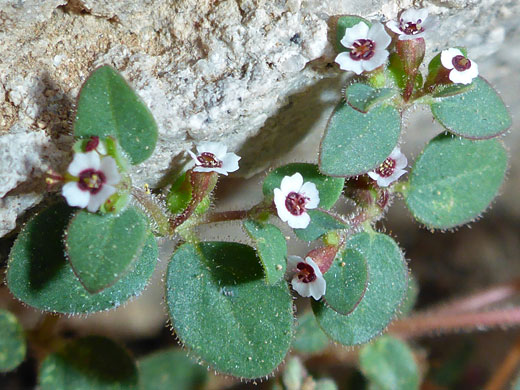Common name:
Arizona sandmat
Family:
Scientific name:
Euphorbia arizonica
Main flower color:
Range:
From southern California to far west Texas
Height:
Up to 12 inches
Habitat:
Rocky hillsides, washes, deserts, woodland, oak chaparral, from near sea level to 4,500 feet
Leaves:
Opposite, ovate, untoothed, sparsely hairy, up to 0.4 inches long
Season:
February to November
The stem and leaf hairs are the best diagnostic feature of euphorbia arizonica, both their presence, as many similar species are glabrous, and also their characteristics, being shiny, glistening and translucent, and also club-shaped, with a narrow stem and wider tip. Stems grow upright or at an angle rather than along the ground. Leaves are broadly ovate, and asymmetric towards the base; one side is lower than the other. Leaves are hairiest along the margins, and they have a faint midvein.
Flowers have an urn-shaped involucre, relatively long and thin, also sparsely hairy, above which are four dark red glands, oblong or kidney-shaped, each linked to a white, petal-like appendage, usually notched or toothed along the upper edge. At the center are several stamens or pistils. Involucres are attached by short stalks, up to 0.15 inches.
Flowers have an urn-shaped involucre, relatively long and thin, also sparsely hairy, above which are four dark red glands, oblong or kidney-shaped, each linked to a white, petal-like appendage, usually notched or toothed along the upper edge. At the center are several stamens or pistils. Involucres are attached by short stalks, up to 0.15 inches.
All Contents © Copyright The American Southwest | Comments and Questions | Contribute | Site Map


